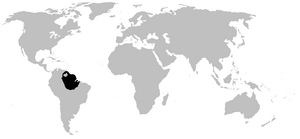Tukeit Hill frog facts for kids
Quick facts for kids Tukeit Hill frogs |
|
|---|---|
| Scientific classification |
|
| Kingdom: | Animalia |
| Phylum: | Chordata |
| Class: | Amphibia |
| Order: | Anura |
| Suborder: | Neobatrachia |
| Clade: | Hyloidea |
| Family: | Allophrynidae Savage, 1973 |
| Genus: | Allophryne Gaige, 1926 |
| Species | |
|
|
 |
|
| Distribution of A. ruthveni (in black) | |
The Tukeit Hill frogs are three types of frogs. They all belong to a group called the genus Allophryne.
These frogs were first put into their own special group called the subfamily Allophryninae. This group was then placed inside the family Centrolenidae. But now, scientists think they are the only members of their very own family, called Allophrynidae.
You can find these frogs in countries like Guyana, Venezuela, Suriname, Brazil, and Bolivia. The first frog of this kind was found at Tukeit Hill in Guyana. This is why they are called Tukeit Hill frogs in English.
Contents
What Do Tukeit Hill Frogs Look Like?
The Tukeit Hill frog is a small frog. Its colors can be different. Some are black with gold or dull yellow stripes and spots. Others are dull yellow or gold with black stripes and spots.
This frog has a flat body and a small, flat head. It has one special pouch under its jaw that it uses to make sounds. Its toe pads are big and wider than its fingers. You can also see its eardrum, called the tympanum.
Tukeit Hill frogs look a bit like tree frogs. But if you look closely, the bones at the ends of their fingers and toes are shaped differently.
How Are Tukeit Hill Frogs Related to Other Frogs?
The Allophryne ruthveni frog was once thought to be the only member of its special group. This group is called Allophryninae. Scientists have always wondered how this frog is related to other frogs.
In the past, people thought it might be related to families like Hylidae (tree frogs) or Bufonidae (toads). But until recently, its closest relatives were a mystery.
Allophryne frogs look similar to tree frogs. But their finger and toe bones are T-shaped at the ends. This is a special feature found in glassfrogs. Tree frogs have claw-shaped bones instead.
A scientist named G. K. Noble studied Allophryne. He thought it might be closely related to glassfrogs. Later studies using phylogenetic methods confirmed this idea. These studies showed that Allophryne is a close relative of the glassfrog group, Centroleninae.
Glassfrogs are different from Allophryne in a few ways. They have more delicate skulls. They also have tiny extra bones between their finger bones. Both glassfrogs and the Allophrynidae family are closely related to the Leptodactylidae family.
Recently, a new type of frog was found in Peru. Scientists think it might be another Allophryne species. This means there might be more Tukeit Hill frogs to discover. It also suggests that these frogs might have lived in more places a long time ago. They might be a relict group, meaning they are survivors from a time when their kind was more common.
What Do Tukeit Hill Frogs Do?
The Tukeit Hill frog spends some of its time in trees, usually 1 to 3 meters high. It also spends time on the ground. They are known as "explosive breeders." This means they quickly lay their eggs when small ponds form on the forest floor after it rains.
These frogs live in forests that are not too dense. They seem to prefer forested areas and avoid places where the land has been cleared.
See also
 In Spanish: Allophryne ruthveni para niños
In Spanish: Allophryne ruthveni para niños

